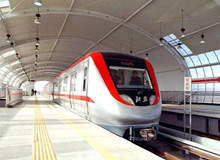
At the end of 2007 there were 17.4 million people living in China's capital, Beijing. Each day many people commute to work on the city's mass transit system, a public resource that is vital to the success of businesses and infrastructure. We take a look at what makes up the rail system and the significant effect it has on the running of the city.
The Beijing subway is the oldest and busiest in mainland China. Its first line entered service in 1971 and it now delivers more than four million commuters to their destinations every day. At the end of 2007 Beijing was home to 751 financial organisations that accounted for 11.6% of the country's total financial revenue.
The primary mode of transport for the majority of them is the city's public transport network. It is the second longest metro system in the country after Shanghai's but is currently undergoing a major expansion, which, when complete in 2015, will see the total length of the subway extended to 561km at a cost of $29.2bn.
Its newest route, Line 4, began operations on 28 September 2009 and already delivers five million riders each day. In 2008 Beijing hosted the Olympics and the city underwent major changes. A three-month period of heightened security was initiated using metal detectors and x-ray machines.
Although the programme stopped at the end of the games it was later reintroduced and, in February 2009, made permanent.
Beijing prides itself on making its subway system user-friendly. Mobile phones can be used throughout the system except in tunnels along Line 1 and Line 2, although there are plans to adapt them to provide cellular access. Subways also allow wheelchair access and have lifts, ramps or elevators.
How well do you really know your competitors?
Access the most comprehensive Company Profiles on the market, powered by GlobalData. Save hours of research. Gain competitive edge.

Thank you!
Your download email will arrive shortly
Not ready to buy yet? Download a free sample
We are confident about the unique quality of our Company Profiles. However, we want you to make the most beneficial decision for your business, so we offer a free sample that you can download by submitting the below form
By GlobalDataThe initial design of the metro was conceived in 1953 when Beijing's transport elite turned to the expertise of Soviet and East German engineers, using the Moscow metro as an inspiration. But as relations between China and Russia deteriorated the project stopped and international experts withdrew by 1963.
Today severe overcrowding has led to a heavy stimulus package to extend routes and upgrade services. During rush hours the subway can become overcrowded and conductors often miss out transfer stops to cut delays for passengers. Upgraded signal equipment has been vital in increasing the frequency of the trains.







